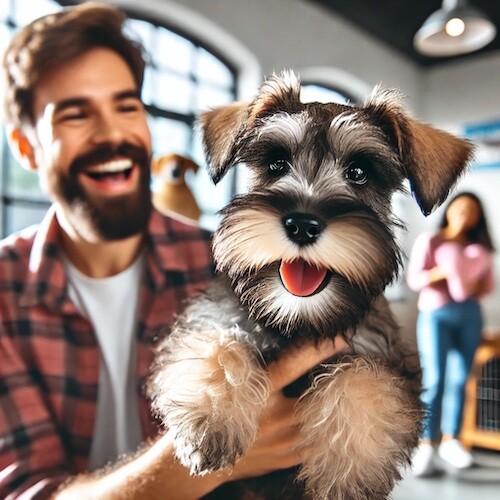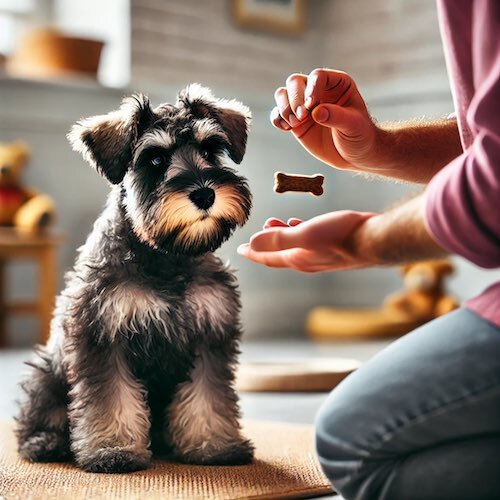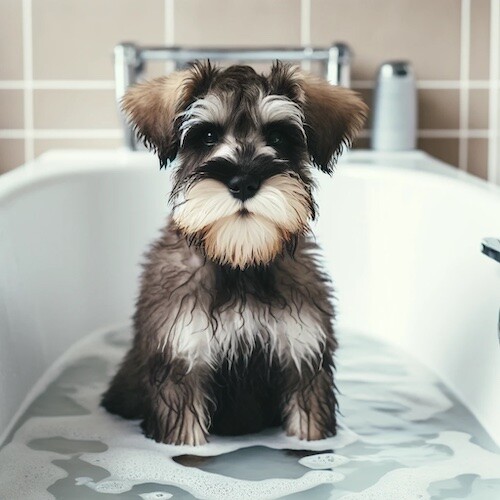
Schnauzer Puppies: The Ultimate Guide for New Dog Owners
Search Best Schnauzer Puppy Products
Introduction on Schnauzer Puppies
Schnauzers are a unique and beloved breed known for their distinctive appearance, intelligence, and affectionate nature. These dogs come in three sizes: Miniature, Standard, and Giant, each with its own set of characteristics but sharing common traits that make Schnauzers a favorite among dog lovers.
Whether you are a first-time dog owner or an experienced pet parent, bringing a Schnauzer puppy into your home can be a rewarding experience. This ultimate guide will provide you with all the information you need to ensure a smooth and successful journey with your new Schnauzer puppy.
Understanding the Schnauzer Breed
History and Origin
The Schnauzer breed originated in Germany in the 15th century. The name “Schnauzer” comes from the German word “Schnauze,” which means “snout,” referring to the breed’s distinctive beard and whiskers. Initially bred as farm dogs, Schnauzers were used for guarding property, hunting rats, and herding livestock. Their versatility and robust nature made them popular working dogs.
- Miniature Schnauzer: Bred by crossing the Standard Schnauzer with smaller breeds like the Affenpinscher and Poodle to create a compact version for ratting on farms.
- Standard Schnauzer: The original Schnauzer, used for guarding and general farm work.
- Giant Schnauzer: Developed by crossing the Standard Schnauzer with larger breeds such as the Great Dane and the Bouvier des Flandres to create a powerful guard dog.
Physical Characteristics
Schnauzers are characterized by their distinctive appearance, which includes a square build, a wiry coat, and bushy eyebrows and beard. Their physical traits vary slightly among the three sizes:
- Miniature Schnauzer: Typically weighs between 11-20 pounds and stands 12-14 inches tall at the shoulder.
- Standard Schnauzer: Weighs between 35-50 pounds and stands 17.5-19.5 inches tall.
- Giant Schnauzer: Weighs between 60-85 pounds and stands 23.5-27.5 inches tall.
All Schnauzers have a double coat with a soft undercoat and a wiry outer coat, which requires regular grooming to maintain.
Temperament and Personality
Schnauzers are known for their intelligence, loyalty, and spirited nature. They are alert and protective, making them excellent watchdogs. Their high intelligence and eagerness to please make them highly trainable, although they can also be stubborn and independent at times.
- Affectionate: Schnauzers form strong bonds with their families and enjoy being involved in all aspects of family life.
- Energetic: They have high energy levels and require regular exercise to stay healthy and happy.
- Playful: Schnauzers are playful and enjoy interactive toys and games.
- Good with Children: They are generally good with children and can be a great family pet with proper socialization.
Preparing for a Schnauzer Puppy
Assessing Your Lifestyle
Before bringing a Schnauzer puppy into your home, it’s important to assess your lifestyle and ensure it aligns with the needs of this breed. Consider the following factors:
- Time Commitment: Schnauzers require daily exercise, mental stimulation, and grooming. Be prepared to invest time in training, playing, and caring for your puppy.
- Living Space: Schnauzers adapt well to various living environments, including apartments and houses, but they need enough space to play and exercise.
- Allergies: While Schnauzers are considered hypoallergenic due to their minimal shedding, their wiry coat can still cause reactions in sensitive individuals.
- Activity Level: Schnauzers have high energy levels and require regular physical activity. Ensure your activity level matches the breed’s needs to keep your puppy healthy and happy.
- Family Dynamics: Schnauzers are generally good with children and other pets, but supervision is essential, especially with younger children. Teach your family members how to interact with the puppy gently and respectfully.
Financial Considerations
Owning a Schnauzer involves various costs, both initial and ongoing. It is essential to budget for these expenses to ensure you can provide proper care throughout the dog’s life:
- Initial Purchase or Adoption Fees: The cost of acquiring a Schnauzer can vary widely depending on the source. Reputable breeders may charge between $1,000 and $3,000, while adoption fees from rescue organizations or shelters are typically lower, ranging from $200 to $500.
- Veterinary Care: Routine veterinary care includes vaccinations, annual check-ups, and preventative treatments for parasites. Additionally, Schnauzers are prone to certain health issues, such as hip dysplasia and eye problems, which may require special attention and treatment.
- Grooming: Regular grooming is essential for maintaining a Schnauzer’s coat and overall health. Professional grooming services can cost between $40 and $100 per session, depending on the groomer and the services provided. Additionally, you will need to purchase grooming supplies such as brushes, combs, shampoo, and nail clippers.
- Food and Supplies: High-quality dog food is crucial for your Schnauzer’s health. Expect to spend around $20 to $50 per month on food. Other supplies include a bed, toys, bowls, a leash, a collar, and training materials.
- Pet Insurance: Consider investing in pet insurance to help cover unexpected medical expenses. Monthly premiums can range from $20 to $50, depending on the coverage level and the provider.
By thoroughly assessing your lifestyle and financial situation, you can ensure that you are well-prepared to welcome a Schnauzer puppy into your home and provide them with the love and care they need to thrive.
Finding a Reputable Breeder
Importance of a Reputable Breeder
Choosing a reputable breeder is crucial for ensuring the health and well-being of your Schnauzer puppy. Responsible breeders adhere to ethical breeding practices and prioritize the health and temperament of their dogs. A reputable breeder will:
- Conduct health screenings on their breeding dogs to identify and avoid passing on genetic conditions.
- Provide a clean, safe, and nurturing environment for their dogs and puppies.
- Ensure that puppies are well-socialized, healthy, and ready for their new homes.
- Offer ongoing support and guidance to new owners.
Working with a reputable breeder increases the likelihood of bringing home a healthy and well-adjusted Schnauzer puppy.
Researching Breeders
Start by gathering recommendations from trusted sources:
- Veterinarians: Your local veterinarian can be a valuable resource for finding reputable breeders. They often have connections within the breeding community and can provide reliable recommendations.
- Local Breed Clubs: Contact local Schnauzer breed clubs or kennel clubs. These organizations often maintain lists of reputable breeders who adhere to high standards of care and ethics.
- Friends and Family: If you know someone who owns a Schnauzer, ask them about their experience with their breeder. Personal recommendations can be very helpful.
- Online Resources: Utilize online directories such as the American Kennel Club (AKC) Breeder Directory and other reputable breeding organizations. These directories typically list breeders who meet specific standards and guidelines.
- Social Media and Forums: Join Schnauzer-specific social media groups and forums. These communities can provide insights and recommendations based on members’ experiences.
Questions to Ask Breeders
When contacting breeders, ask the following questions to ensure they are reputable:
- How long have you been breeding Schnauzers? Experience matters, as long-term breeders are more likely to have refined their breeding practices.
- Can I see the puppies’ parents and their living conditions? Visiting the breeder’s facility and observing the environment helps assess the conditions in which the puppies are raised.
- What health tests do you perform on the breeding dogs? Reputable breeders will conduct health screenings for genetic conditions such as hip dysplasia, eye diseases, and other breed-specific issues.
- Do you provide a health guarantee for the puppies? A health guarantee indicates that the breeder stands behind the health of their puppies and is willing to address any issues that may arise.
- Can you provide references from previous buyers? Speaking with past buyers can provide insights into the breeder’s reputation and the quality of their puppies.
Visiting the Breeder
If possible, visit the breeder’s facility to observe the environment and meet the puppies and their parents. A reputable breeder will be transparent and welcome your visit. Pay attention to the following:
- Cleanliness: The facility should be clean and well-maintained, with no signs of neglect or overcrowding.
- Dog Temperament: Observe the temperament of the puppies and their parents. They should be friendly, curious, and well-socialized.
- Overall Conditions: Assess the living conditions of the dogs. They should have access to clean water, proper shelter, and appropriate space to move around.
- Breeder Interaction: A reputable breeder will be knowledgeable, transparent, and willing to answer all your questions. They should provide detailed information about the puppies’ health, care, and lineage.
By conducting thorough research and asking the right questions, you can find a reputable breeder who will provide you with a healthy and well-adjusted Schnauzer puppy.
Understanding Health Concerns
Ensuring the health and well-being of your Schnauzer is crucial to providing a happy, fulfilling life for your new companion. Schnauzers are prone to several health issues due to their unique physical characteristics and genetic predispositions. Being aware of these potential health problems and ensuring that proper screenings are conducted can help you select a healthy puppy and manage their health throughout their life.
Common Health Issues in Schnauzers
Hip Dysplasia
Hip dysplasia is a genetic condition where the hip joint doesn’t fit properly into the hip socket, causing pain and mobility issues. This condition is more common in larger breeds, such as the Giant Schnauzer, but can also affect Miniature and Standard Schnauzers. Symptoms may include limping, reluctance to jump or climb stairs, and decreased activity levels. Early detection through X-rays and a hip evaluation by the Orthopedic Foundation for Animals (OFA) can help manage the condition through weight management, physical therapy, and, in severe cases, surgery.
Eye Problems
Schnauzers are prone to various eye problems due to their prominent eyes. Common issues include cataracts, which cause clouding of the lens and can lead to blindness if untreated, and Progressive Retinal Atrophy (PRA), a genetic condition that gradually deteriorates the retina, also leading to blindness. Regular eye check-ups with a veterinary ophthalmologist can help detect and manage these conditions early. Additionally, keeping the area around the eyes clean and free of hair can prevent irritation and infections.
Pancreatitis
Schnauzers, particularly Miniature Schnauzers, are predisposed to pancreatitis, an inflammation of the pancreas that can cause severe abdominal pain, vomiting, and diarrhea. Pancreatitis can be triggered by high-fat diets or obesity. Maintaining a healthy diet and weight for your Schnauzer is crucial in preventing this condition. If you suspect pancreatitis, seek immediate veterinary care as it can be life-threatening if left untreated.
Hypothyroidism
Hypothyroidism is a condition where the thyroid gland doesn’t produce enough thyroid hormone, leading to symptoms such as weight gain, lethargy, and skin issues. This condition is common in Standard Schnauzers. Regular veterinary check-ups and blood tests can diagnose hypothyroidism, which can be managed with daily medication and monitoring.
Health Screening
To ensure you bring home a healthy Schnauzer puppy, it is essential to verify that the breeder performs the following health screenings on their breeding dogs:
- Hip Dysplasia Screening: Breeders should screen for hip dysplasia through X-rays and evaluations by organizations like the Orthopedic Foundation for Animals (OFA).
- Eye Examination: Regular eye examinations by a board-certified veterinary ophthalmologist are crucial to detect conditions like PRA and cataracts. Breeding dogs should have their eyes cleared of these hereditary issues.
- Thyroid Testing: Screening for thyroid function can help detect hypothyroidism in breeding dogs.
- Pancreatitis Screening: Breeders should monitor and manage the dietary health of their breeding dogs to prevent pancreatitis.
By ensuring that these screenings are conducted, you can significantly reduce the risk of inheriting genetic health issues and increase the chances of bringing home a healthy Schnauzer puppy.

Adopting a Schnauzer
Adopting a Schnauzer from a rescue organization is a fulfilling and compassionate alternative to purchasing from a breeder. Many Schnauzers in rescues need loving homes due to various circumstances, and adopting a rescue dog can provide them with a second chance at a happy life.
Rescue Organizations
National Breed Clubs
National breed clubs, such as the American Miniature Schnauzer Club or the Standard Schnauzer Club of America, often have dedicated rescue networks. These organizations are committed to the welfare of Schnauzers and work to rescue and rehome dogs in need. They provide valuable resources and support throughout the adoption process.
Local Animal Shelters
Check with local animal shelters and rescue groups in your area. Many shelters have Schnauzers or similar breeds available for adoption. Visiting these shelters can give you a chance to meet various dogs and find the one that best fits your family and lifestyle.
Online Platforms
Websites like Petfinder and Adopt-a-Pet are excellent resources for finding adoptable Schnauzers. These platforms allow you to search for specific breeds and filter results by location, age, and other criteria. They often list dogs from various rescue organizations and shelters, providing a wide range of options.
The Adoption Process
Adopting a Schnauzer involves several steps to ensure a good match between the dog and the adopter. The process typically includes the following:
- Application: You will need to complete an adoption application, providing information about your home, lifestyle, and experience with pets. This helps the rescue organization assess your suitability as a potential adopter.
- Interview: An interview or home visit may be conducted to further assess your suitability and to discuss the specific needs of the dog you are interested in adopting. This step ensures that the adoption is a good fit for both you and the dog.
- Adoption Fee: A fee is usually required to cover the costs of veterinary care, vaccinations, spaying or neutering, and other expenses incurred by the rescue organization. Adoption fees vary but are typically between $100 and $500.
- Adoption Agreement: You will be asked to sign an adoption agreement outlining your responsibilities as the new owner. This contract may include provisions for the dog’s care, return policies if the adoption does not work out, and other terms to ensure the dog’s well-being.
Evaluating the Puppy
Whether adopting or purchasing a Schnauzer puppy, evaluating their behavior and health is crucial to ensuring you bring home a well-rounded and healthy companion.
Behavioral Assessment
Observe the puppy’s behavior to ensure they have a well-rounded temperament. Look for the following:
- Socialization: The puppy should be comfortable interacting with people and other animals. Properly socialized puppies are more likely to grow into well-adjusted adults.
- Curiosity: A healthy level of curiosity and playfulness is a good sign. Puppies should be eager to explore their environment and engage with toys and people.
- Calmness: The ability to relax and not show excessive anxiety or aggression is important. Puppies should be able to settle down and rest after playtime.
Health Check
Conduct a basic health check to identify any immediate concerns:
- Eyes and Ears: Ensure the puppy’s eyes are clear, bright, and free from discharge. Their ears should be clean and without odor or redness, indicating no infections or ear mites.
- Coat and Skin: The coat should be clean, shiny, and free from bald patches or irritation. Healthy skin should be free of rashes, scabs, or excessive dandruff.
- Movement: Watch the puppy move to ensure there are no signs of limping, stiffness, or difficulty walking. Healthy puppies should have a smooth, coordinated gait.
- Breathing: The puppy’s breathing should be normal, without excessive panting, coughing, or wheezing. Severe respiratory issues should be absent.
By thoroughly evaluating the puppy’s behavior and health, you can make an informed decision and choose a Schnauzer that will be a joyful and healthy addition to your family.
Bringing Your Schnauzer Puppy Home
Bringing a Schnauzer puppy into your home is an exciting and joyous occasion. However, it also requires thorough preparation to ensure your new furry friend feels safe, comfortable, and loved. This section will guide you through the essential steps to prepare your home and introduce your puppy to their new environment.
Preparing Your Home
Creating a welcoming and safe environment for your Schnauzer puppy is crucial for their well-being and adjustment. Here are detailed steps to prepare your home:
Create a Comfortable Space
Designate a specific area in your home where your puppy can feel secure. This space should include:
- A Cozy Bed: Choose a soft, comfortable bed that is appropriate for their size. Ensure it is washable and placed in a quiet, low-traffic area of the house.
- Water and Food Bowls: Use sturdy, non-tip bowls for food and water. Keep them clean and filled with fresh water at all times.
- Toys: Provide a variety of toys to keep your puppy entertained and stimulated. Include chew toys, interactive toys, and plush toys to cater to different play styles.
Puppy-Proofing
Puppies are naturally curious and will explore their new surroundings. To ensure their safety, take the following precautions:
- Remove Hazardous Items: Store away any items that could be harmful if ingested, such as cleaning supplies, medications, and small objects that can be swallowed.
- Secure Loose Wires: Use cord protectors or secure loose wires to prevent chewing and potential electrical hazards.
- Block Off Dangerous Areas: Use baby gates to restrict access to stairs, balconies, and rooms with potential hazards.
- Household Plants: Check that your houseplants are non-toxic to dogs and place them out of reach.
Supplies
Having the necessary supplies ready before bringing your puppy home will make the transition smoother:
- Food: Choose high-quality puppy food recommended by your breeder or veterinarian. Gradually transition to a new brand if needed to avoid digestive issues.
- Leash and Collar: Get a comfortable, adjustable collar and a sturdy leash for walks and training.
- Grooming Tools: Invest in grooming supplies such as brushes, combs, nail clippers, and dog shampoo to maintain your Schnauzer’s coat and hygiene.
Initial Veterinary Visit
Scheduling a veterinary visit shortly after bringing your puppy home is essential for their health and well-being. During this visit, the vet will:
- Conduct a Thorough Health Check: The vet will examine your puppy to ensure they are healthy and free from any congenital or infectious diseases.
- Begin a Vaccination Schedule: Puppies require a series of vaccinations to protect them from common diseases. Your vet will outline a vaccination schedule tailored to your puppy’s needs.
- Provide Guidance on Nutrition and Care: Your vet will offer advice on feeding, grooming, and general care. They can also answer any questions you may have about raising your Schnauzer.

Training and Socialization
Training and socialization are crucial components of raising a well-behaved and confident Schnauzer. Starting early with consistent training and exposure to various environments will set the foundation for a well-adjusted adult dog.
Basic Training
House Training
House training is one of the first tasks you will need to tackle. Consistency and positive reinforcement are key:
- Establish a Routine: Take your puppy outside frequently, especially after meals, naps, and playtime. Consistent schedules help puppies learn when and where they should go.
- Positive Reinforcement: Praise and reward your puppy with treats and affection immediately after they eliminate outside. Avoid punishment for accidents, as it can create fear and confusion.
- Designated Spot: Choose a specific area in your yard for your puppy to use as a bathroom spot. The scent will remind them where to go.
Obedience Training
Teaching basic commands helps establish good behavior and strengthens the bond between you and your puppy:
- Sit: Hold a treat above your puppy’s nose and move it back over their head. As their head follows the treat, their bottom will naturally lower. Once they sit, say “sit” and reward them.
- Stay: Start with your puppy in a sitting position. Hold your hand up, palm out, and say “stay.” Gradually increase the distance and duration before giving the release command.
- Come: Use a leash for this command. Gently pull the leash towards you while saying “come.” Reward your puppy when they reach you.
Leash Training
Introduce your Schnauzer to leash walking gradually:
- Short Walks: Begin with short walks around your yard or home to get your puppy accustomed to the leash.
- Positive Experiences: Encourage and reward your puppy for walking calmly beside you. Avoid pulling or dragging them.
- Consistency: Practice leash walking regularly to build confidence and good habits.
Socialization
Early socialization is vital for developing a confident and well-adjusted Schnauzer:
- Exposure to People: Introduce your puppy to a variety of people, including children, adults, and strangers. Positive interactions help them become comfortable around new faces.
- Interaction with Other Animals: Arrange playdates with other dogs and expose your puppy to other pets like cats. Supervised interactions teach them appropriate behavior and reduce fear.
- Different Environments: Take your puppy to various places, such as parks, pet-friendly stores, and friends’ homes. Diverse experiences reduce anxiety and build adaptability.

Ongoing Care
Maintaining your Schnauzer’s health and well-being requires ongoing care and attention. Regular grooming, proper nutrition, adequate exercise, and routine veterinary visits are essential for their overall health.
Grooming
Schnauzers have a luxurious double coat that requires regular grooming to keep it healthy and free from tangles:
Daily Brushing
Daily brushing is essential to prevent mats and tangles in their long coat:
- Tools: Use a pin brush or slicker brush to gently remove tangles and loose hair. A comb can help with finer tangles and to check for any matting close to the skin.
- Technique: Start from the head and work your way down to the tail, being gentle to avoid causing discomfort. Pay special attention to areas prone to matting, such as behind the ears and under the legs.
Bathing
Bathing every 3 to 4 weeks keeps your Schnauzer’s coat clean and healthy:
- Shampoo: Use a gentle, dog-specific shampoo to avoid skin irritation. Ensure thorough rinsing to remove all shampoo residue.
- Drying: Towel dry your Schnauzer gently, then use a blow dryer on a low setting to dry their coat completely. Ensure the coat is thoroughly dried to prevent moisture-related skin issues.
Professional Grooming
Regular visits to a professional groomer are recommended for haircuts, nail trimming, and overall maintenance:
- Haircuts: Depending on your preference, you may choose to keep your Schnauzer’s coat long or opt for a shorter, more manageable trim.
- Nail Trimming: Regular nail trimming prevents overgrowth and discomfort. If you are uncomfortable doing it yourself, a groomer or vet can assist.
Nutrition
Providing a balanced diet is essential for your Schnauzer’s health and vitality:
High-Quality Dog Food
Choose a high-quality dog food formulated for small breeds:
- Ingredients: Look for dog food with real meat as the first ingredient, along with whole grains, vegetables, and essential vitamins and minerals.
- Avoid Fillers: Avoid foods with excessive fillers like corn, wheat, and soy, as they can cause allergies and digestive issues.
Top 10 Best Rated Dog Food Brands for Schnauzers
Portion Control
Monitor your Schnauzer’s food intake to prevent obesity:
- Feeding Schedule: Establish a consistent feeding schedule, typically two to three meals a day for puppies and two meals a day for adults.
- Measure Portions: Use a measuring cup to ensure you are feeding the correct amount based on the dog’s age, weight, and activity level.
Hydration
Ensure your Schnauzer has access to fresh water at all times:
- Water Bowl: Keep a clean water bowl filled with fresh water and change it daily to ensure hydration and prevent bacterial growth.
Exercise
Regular exercise is crucial for maintaining your Schnauzer’s physical and mental health:
Daily Walks
Short, daily walks help burn energy and stimulate their minds:
- Duration: Aim for two 15-minute walks per day, adjusting based on your dog’s age, health, and energy levels.
- Variety: Vary your walking routes to keep your Schnauzer engaged and expose them to new sights and smells.
Playtime
Interactive play sessions provide additional exercise and mental stimulation:
- Toys: Use a variety of toys, including fetch toys, puzzle toys, and chew toys to keep your Schnauzer entertained.
- Engagement: Spend quality time playing with your dog to strengthen your bond and keep them active.
Monitoring Health
Regular veterinary care and monitoring are essential for catching potential health issues early and maintaining your Schnauzer’s well-being:
Regular Vet Check-Ups
Schedule routine veterinary visits to monitor your Schnauzer’s health:
- Dental Care: Regular dental check-ups and professional cleanings are vital to prevent dental diseases. Brush your dog’s teeth regularly using dog-specific toothpaste.
- Vaccinations: Keep up-to-date with vaccinations and boosters to protect against common diseases.
- Parasite Control: Administer regular treatments for fleas, ticks, and worms as recommended by your vet.
By following these guidelines and providing consistent care, you can ensure that your Schnauzer enjoys a long, healthy, and happy life as a cherished member of your family.
Conclusion
Finding the best Schnauzer puppy involves careful research, preparation, and ongoing commitment to their care. Understanding the breed’s characteristics, selecting a reputable breeder or rescue organization, and preparing your home are the first steps in this rewarding journey. Training, socialization, and regular health care are essential for raising a well-adjusted and healthy companion.
Whether you choose to buy or adopt, the joy and companionship of a Schnauzer will be a rewarding experience for years to come. With love, patience, and dedication, you can ensure that your Schnauzer thrives and becomes a cherished member of your family.
